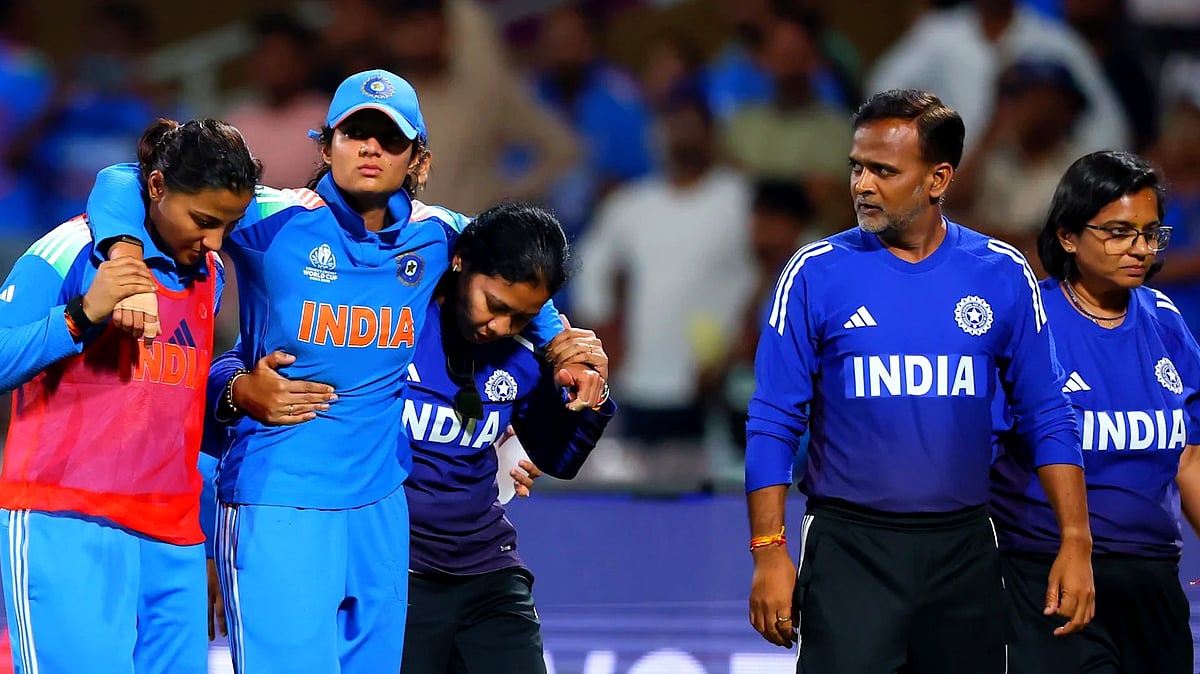Women's World Cup: India Face Injury Scare As Pratika Twists Ankle Before Semis
ICC Women's World Cup 2025: Having scored 301 runs so far, Pratika Rawal is a player India can ill-afford to miss.

advertisement
Having already qualified for the semi-final of the 2025 ICC Women’s World Cup, courtesy of their victory over New Zealand, and with a seemingly unrelenting, unstoppable Australia looming on the horizon, India’s wishlist for Sunday’s (26 October) match against Bangladesh was limited. A victory in a match like this would only have a psychological effect, but in terms of tangible returns, India would have wanted a few of their usually-benched players to have a good run, and prevent any injuries.
The former aspiration was realised. Radha Yadav, playing only her first match in the tournament, picked up three wickets. Amanjot Kaur, making a return to the playing XI, took one wicket for 18 runs in her five-over spell, and then remained unbeaten on a 25-ball 15 in the chase.
Bangladesh Struggle With The Bat, Again
Earlier, the match was reduced to 27 overs per side owing to multiple stints of showers. Asking Bangladesh to bat first, India took very little time to justify the decision as Renuka Singh, having found rhythm on the back of her two wickets against New Zealand, dismissed Sumaiya Akter in the very first over.
A 34-run partnership between Rubya Haider Jhelik and Sharmin Akhter Supta seemed to have settled Bangladesh’s ship, but it was not backed by any partnership enough for Bangladesh to post a significant score.
Spinners Didn't Let Aavishkar Salvi Down
There is not much to report from the Bangladeshi innings otherwise, except that their final score was 119/9. For India, however, spinners causing trouble on what is otherwise a batting-friendly track at the DY Patil Stadium was a major positive. Deepti Sharma, Shree Charani and Radha Yadav combined to pick up six of Bangladesh’s nine wickets, whilst conceding only 77 runs in 17 overs.
On the eve of the match, The Quint had asked Aavishkar Salvi, India’s bowling coach, about whether playing their remaining matches at the DY Patil Stadium might prove to be costly, for the venue usually offers very little purchase to what is India’s prized asset — the spinners.
Salvi had shown faith in his spinners by saying:
Pratika Rawal's Injury A Major Concern, But Harmanpreet Kaur Is Hopeful
India will be content with how Salvi’s words were instantaneously validated, as they will be with Smriti Mandhana’s continued streak of scoring with ease. She had struck 34 runs from only 27 deliveries when rain halted play, resulting in the abandonment of the game. India had scored 57/0 from 8.4 overs, and were on course for what would have been a comfortable victory, had it not been for rain playing spoilsport yet again in this tournament — albeit not in Colombo on this occasion, for a change.
Ahead of the match against Australia, however, India will be concerned about the extent of Pratika Rawal’s injury, who was visibly distressed after the ankle twist. For, she has scored 308 runs in this competition at an average of 51.33, 75 of which came against Australia itself.
Speaking about her status after the game, skipper Harmanpreet Kaur said:
Bangladesh Finishes Ahead Of Pakistan
As for Bangladesh, they would feel rain has done them poetic justice after suffering agonisingly narrow defeats against England, South Africa and Sri Lanka. Now tied on three points with Pakistan, Bangladesh will finish ahead of Fatima Sana’s team, in the seventh position, courtesy of having won more matches than Pakistan.
Bangladesh’s captain Nigar Sultana Joty, who seemed distraught after the previous defeat to the Lankans, spoke about the positives that they can take from this campaign, with the seventh-place finish also securing a sizeable financial package for the team.
Navi Mumbai Fans Break Attendance Record Yet Again
Notably, the crowd at the DY Patil Stadium deserves plaudits for having turned up in huge numbers. A total of 25,965 fans attended the match, which is the highest attended league stage game of any ICC women’s tournament, breaking the previous record of 25,166, created on this stadium itself on 23 October’s match against New Zealand.
In the other semi-final, two-time champions England will face South Africa, who are aiming to qualify for the final of the ODI World Cup for the first time in their history.